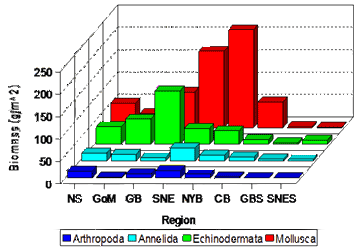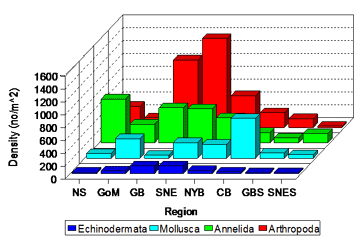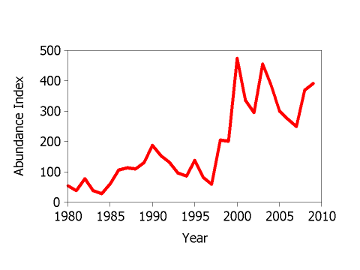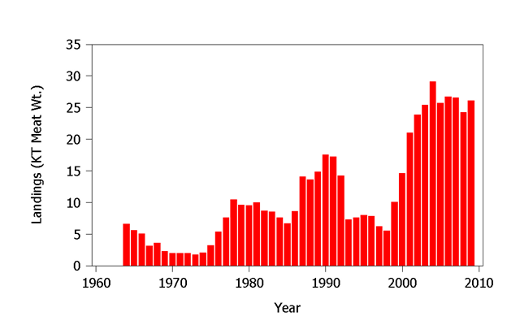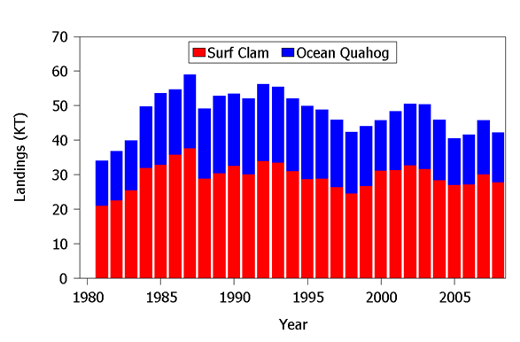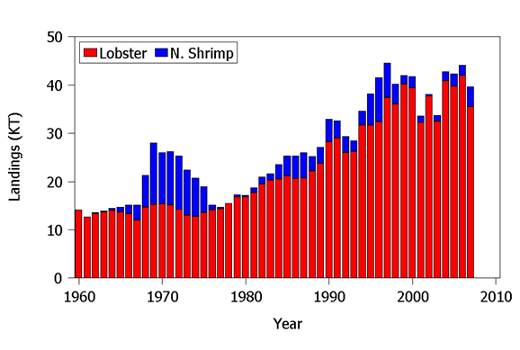Ecology of the Northeast US Continental Shelf
Bottom Life
The animals that live on the bottom or in the sediments are called benthos. Benthic animals play an important role in energy transfer because they are utilized as prey by fish and larger crustaceans. They recycle nutrients and contaminants in water and sediments, and are used as indicators of habitat quality because of their close association with sediments and sedentary life-style. Over 2000 benthic invertebrate species have been identified in the Northeast U.S. Continental Shelf Large Marine Ecosystem (NES LME); however most of these species are relatively rare, occurring in far less than 1% of the samples examined. Many benthic animals support important commercial and recreational fisheries. In fact, many of these species are among the most valuable resources in the region. Clams, oysters, scallops and other molluscs as well as lobsters, crabs, and sea urchins are all economically valuable benthic species. Many of these species have undergone wide fluctuations in abundance over the last several decades with potentially important effects on the ecosystem structure as a whole.
Spatial Patterns
The abundance of benthic organisms exhibit distinctive geographical differences in the NES LME, reflecting differences in sediment composition, depth, temperature, food availability and other factors. An extensive sampling program conducted during 1956-65 remains the only comprehensive source of information on broad-scale distribution patterns throughout the NES LME and adjacent continental slope. In this survey, molluscs (particularly clams and scallops) and echinoderms (including starfish, brittle stars, sand dollars, sea urchins and sea cucumbers) made up a major portion of the benthic invertebrate biomass throughout the shelf. The highest overall benthic invertebrate biomass was found in the Mid-Atlantic Bight. This biomass was dominated by molluscs with highest levels observed in the Southern New England-New York Bight regions (Figure 3). Relatively high biomass of both echinoderms and molluscs was observed on Georges Bank (Figure 3). Relatively low overall benthic invertebrate biomass was found in the Gulf of Maine (particularly in the deep-water basins), Scotian Shelf, and Chesapeake Bight regions (Figure 3). In general, a reduction in benthic biomass is observed with increasing depth, particularly on the continental slope. This diminution reflects a decrease in available food supply for benthic organisms with increasing depth. Uniformly low biomass levels were observed on the slope adjacent to Georges Bank and Southern New England (Figure 3).
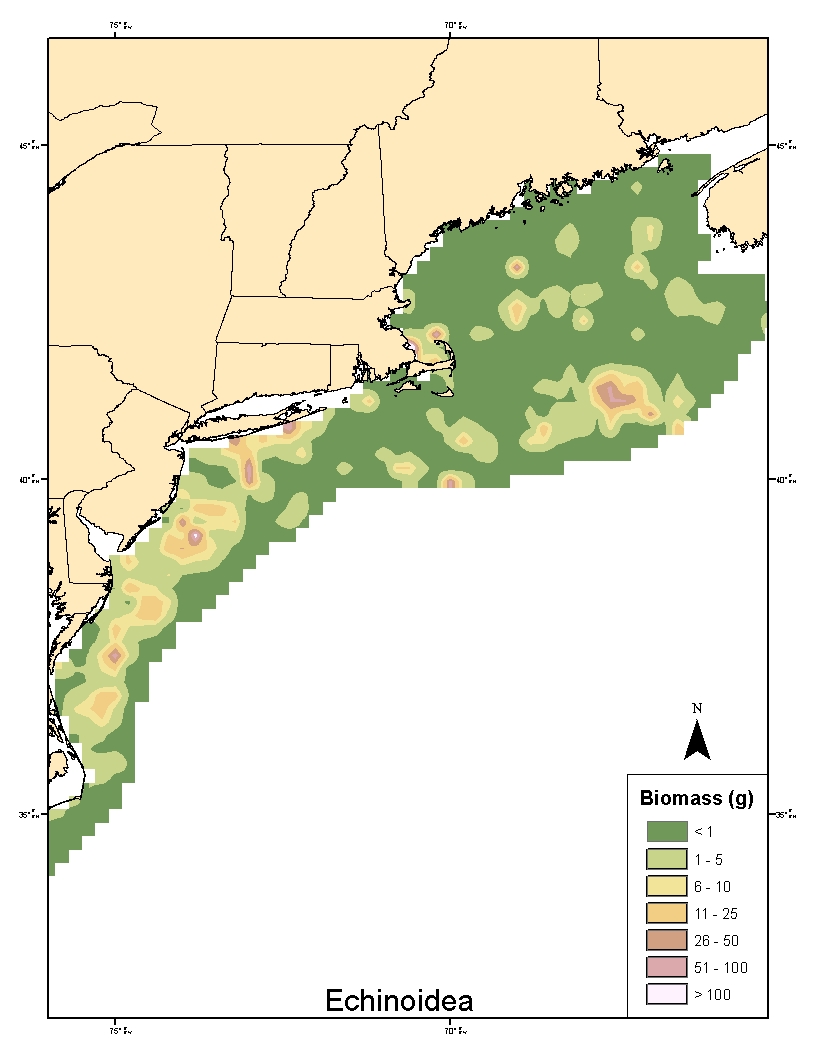 Echinoidea (Sea Urchins) |
Bivalvia (Clams) |
Annelida (Worms) |
Ascidiacea (Sea Squirts) |
Cnidaria (Sea Anemonies) |
Amphipoda (Sand Fleas) |
Decapoda (Crabs, and Shrimp) |
Ophiuroidea (Brittle Stars) |
Gastropoda (Snails) |
Asteroidea (Sea Stars)
Echinoidea (Sea Urchins) |
Bivalvia (Clams) |
Annelida (Worms) |
Ascidiacea (Sea Squirts) |
Cnidaria (Sea Anemonies) |
Amphipoda (Sand Fleas) |
Decapoda (Crabs, and Shrimp) |
Ophiuroidea (Brittle Stars) |
Gastropoda (Snails) |
Asteroidea (Sea Stars)
In contrast, annelids (marine worms) and small crustaceans (notably amphipods) were numerically dominant on the shelf (Figure 4). Highest concentrations of arthropods were found from Georges Bank to the New York Bight. The annelids exhibited a generally declining trend from north to south (Figure 4) while numerical abundance of molluscs peaked in the Chesapeake Bight. The echinoderms were most abundant on Georges Bank and off Southern New England.
Spatial distribution patterns at a finer level of taxonomic resolution are illustrated in Figure 5 for two groups of molluscs [bivalves and gastropods (snails)], three types of echinoderms [asteroids (star fish), echinoids (sea urchins and sand dollars) and ophiuroids (brittle stars)], and two groups of arthropods [decapods (shrimp, lobsters, and crabs) and amphipods ('sand fleas)]. Also depicted are distribution patterns of the annelids, ascidians (sea squirts) and the benthic coelenterates (including sea anemones, sea pens, hard and soft corals).
Habitat Associations
Sediment grain size, sediment organic content (an indicator of food availability), and oxygen content at depth are some of the important habitat features that influence the distribution benthic invertebrates. At a particular location, sediment characteristics are affected by depth and bottom currents. In general, species feeding on the sediment itself and extracting the associated food particles (so-called deposit feeders) are usually found in finer grain size sediments with a higher percentage of mud (silt and clay) and a higher organic food content. These habitats are found in deeper or protected areas were the currents allow finer particles and organic food to settle on to the sediments. However, other species such as the sand dollar which scrapes food from the bottom surface itself prefers sandy sediments.
In contrast, species that strain food particles (including planktonic organisms and organic debris) from the water column generally prefer coarser sediments. These filter feeders include the economically important bivalve molluscs. For example, sea scallop are generally associated with firm sand, gravel, shells, and rock while other bivalves such as surf clams prefer sandy habitats (often found in shallow open areas). Other species such as the sand dollar which scrapes food from the bottom surface itself, prefers sandy sediments.
In soft substrate environments, tube-building worms and amphipods can themselves be important architects of biogenic habitats, providing refuge for other species, including juveniles of economically and ecologically important fish species.
Benthic organisms attached to hard substrates (bedrock, boulders, cobble etc) can play an important role in increasing the structural complexity of these habitats. In shallow-water environments, attached benthic organisms in hard substrate areas, including sponges, hydroids, anemones, oysters, mussels, jingle shells, serve to structure the habitats in important ways, often defining the character of the benthic community and again providing cover for resident and transient fishes.
Submarine canyons support a particularly high diversity of habitats as a result of excavation of layers of ancient sediments, their function as channels for debris flows, their variety of current regimes, and their large range of depths, all within a relatively small area. Sediment types range from outcrops and boulders to sand, silt, and clay in a variety of combinations and configurations. There is a corresponding variety in the benthic surface-dwelling (epifaunal) communities that these habitats support: more than is found in other habitats of similar depth. While some of those communities are similar to ones found outside of canyons, some canyon communities are found nowhere else. Some prominent members include sea anemones, zoanthids (colonial anemones), sponges, hard and soft corals, sea stars, lobsters, squat lobsters (galatheids), shrimp and crabs. Communities of burrowing bottom dwellers (infauna) have received less attention in the canyon areas, reflecting, in part, sampling difficulties. One exception is a type of burrowing community known as a "pueblo village". These habitats consist of burrow complexes in hard clay, often steeply sloped, in canyon walls. Burrowing is thought to be initiated by tilefish, but the habitats are also inhabited by lobsters, conger eels, Jonah crabs, squat lobsters, sea stars, and ocean pout in New England canyons. Similar habitats have been described from Hudson Canyon.
Temporal Trends
Information on long term trends in abundance is primarily available only for selected commercially and recreationally important benthic species. Overall sea scallop abundance as measured by the Northeast Fisheries Science Center dredge surveys increased dramatically from the mid 1990s through the beginning of the present decade (Figure 6). Estimated abundance has since fluctuated around this higher level (Figure 6) . This overall increase is related to the implementation of effective management measures including reductions in fishing effort, gear restrictions, and the establishment of long-term closed areas. Other factors such as the reduction in predation pressure and favorable environmental conditions may also be involved.
Estimated abundance of the American lobster increased steadily from the early 1980s in the Gulf of Maine, peaking in 2002 and then declining (Figure 7), paralleling increases in landings in this region. Abundance on Georges Bank remained relatively stable during the same period while recent abundance trends peaked in the mid-1990s in the Southern New England region (Figure 7). The decline in Southern New England appears to be related, in part, to an increased incidence of shell disease and unfavorable environmental conditions related to increased temperature.
Fisheries
Shellfish species including clams, mussels, and oysters were important parts of the diet of native peoples in coastal areas, as evidenced by the extensive shell middens to be found in many locations along the eastern seaboard. Other species such as lobster were also known to be important, although their remains are not well preserved in these archeological sites. Today, benthic invertebrate species support some of the highest value fisheries on the Northeast Continental Shelf with lobster and scallops typically accounting for the highest revenues (see Economic Considerations) over the last decade or more. Here, we focus on species with important fishery components on the Northeast Continental Shelf; many other invertebrate species with dominant inshore fishery concentrations are also economically and ecologically important.
The fishery for sea scallops has undergone a classical boom-bust cycle with periods of increasing landings followed by declines. There has been, however, an overall upward trend over the last four decades and landings of this species on a coastwide basis are currently at high levels (Figure 8). This pattern is consistent with the high abundance levels shown in Figure 6. As noted in the Economic Considerations chapter, scallops have recently overtaken lobster as the highest revenue fishery in the region.
Other important bivalve fisheries on the shelf include those for Surf Clams and Ocean Quahogs. These fisheries are prosecuted by hydraulic dredges and have had relatively stable landings patterns over the last three decades (Figure 9). These fisheries are managed under strict output quota controls.
The American lobster fishery has been a mainstay of coastal fishing communities for over a century. In the late 1950s the fishery expanded to offshore areas, including the edge of the continental shelf. These offshore fisheries were originally prosecuted using trawl gear but by the 1960s deepwater trap fisheries became increasingly prominent. Coastwide landings of lobsters increased steady starting the early 1960s and have started to tail off, currently fluctuating around a relatively high level (Figure 10). However, sharp regional differences have emerged with large declines in lobster landings in the more southern portion of the range. The landings have historically been dominated by the Gulf of Maine fisheries where the largest concentrations of lobsters are found. As noted above, recent evaluations of resource status indicate declines in the abundance of lobster in the Gulf of Maine.
Other crustacean species also support very valuable fisheries in the region, including those for shrimp and crabs. A relatively small but important fishery for northern shrimp (Pandalus borealis) occurs in the Gulf of Maine. This species supports major fisheries in cold-water regions of the North Atlantic. Landings from the fishery in the Gulf of Maine fluctuate substantially over time, in large measure reflecting changes in water temperatures. This species is at the southern extent of its range in the Gulf of Maine. The he highest landings occurring during the cold water temperatures during the late 1960s through the mid-1970s.
Further Reading
Theroux, R.B. and M.D. Grosslein. 1987. Benthic Fauna. Chapter 26. In: (Backus, RH, ed.) Georges Bank. Cambridge, MA: MIT Press; p. 283-295.
Reid, R.N., D.J. Radosh, A.B. Frame, and S.A. Fromm. 1991. Benthic macrofauna of the New York Bight, 1979-1989. NOAA Technical Report NMFS-103; 50 p.
Steimle, FW Jr. 1987. Production by the benthic fuana. Chapter 29. In: (Backus, RH, ed.) Georges Bank. Cambridge, MA: MIT Press; p. 310-314.
Steimle, FW Jr. 1990. Benthic macrofauna and habitat monitoring on the continental shelf of the Northeastern United States. 1. Biomass. NOAA Technical Report NMFS-86; 28 p.
Theroux, RB and R.I. Wigley. 1998. Quantitative composition and distribution of macrobenthic invertebrate fauna of the continental shelf ecosystems of the Northeastern United States. NOAA Technical Reptort NMFS-140; 240 p.
Wigley, RI; Theroux, RB. 1981. Macrobenthic fauna from the Middle Atlantic Bight region. Faunal composition and quantitive distribution. U.S. Department of the Interior Geological Service Prof. Paper 529 N; 198 p.
Williams, AB. 1984. Shrimp, lobsters, and crabs of the Atlantic coast of the eastern United States, Maine to Florida. Washington DC: Smithsonian Institution Press; 550 p.
For more information, contact Joseph Vitaliano



